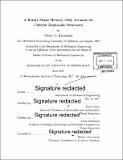| dc.contributor.advisor | Kerri Cahoy and Leon Glicksman. | en_US |
| dc.contributor.author | Khatsenko, Maxim O | en_US |
| dc.contributor.other | Massachusetts Institute of Technology. Department of Mechanical Engineering. | en_US |
| dc.date.accessioned | 2017-10-04T15:06:50Z | |
| dc.date.available | 2017-10-04T15:06:50Z | |
| dc.date.copyright | 2017 | en_US |
| dc.date.issued | 2017 | en_US |
| dc.identifier.uri | http://hdl.handle.net/1721.1/111751 | |
| dc.description | Thesis: S.M., Massachusetts Institute of Technology, Department of Mechanical Engineering, 2017. | en_US |
| dc.description | Cataloged from PDF version of thesis. | en_US |
| dc.description | Includes bibliographical references (pages 155-158). | en_US |
| dc.description.abstract | Over a decade of continuing CubeSat technology improvements are driving the wide adoption of CubeSats for research and commercial missions. Resource constraints onboard CubeSats still limit their ability to support multi-use actuators, but there is a need for a rotary CubeSat actuator that can be actively commanded to different angles. This type of actuator can be implemented in a CubeSat mechanism for differential drag management, increased power generation, and reconfigurable deployable structures. We propose using a shape memory alloy (SMA) actuator to meet this need. A SMA can be annealed at high temperatures to remember a trained shape. Upon cool down, the SMA element transforms to the martensite phase and is easily deformed. When the element is heated above the transformation temperature it transforms to the stiff austenite phase and assumes its remembered shape, driving the mechanism. Two SMA actuators are trained to different shapes and provide bidirectional rotary motion for use as a space mechanism. The actuators are designed by implementing kinematic, thermal, and bending models to size the SMA element. The models also predict the performance, size, weight, and power of the actuator and ensure it can operate in the CubeSat environment. Then, a prototype of the proposed actuator is manufactured, assembled, and ground tested. Testing is used to validate the models and verify the requirements necessary to operate onboard a CubeSat. The prototype meets all requirements and offers a reduced mass, volume, and complexity alternative to current CubeSat electromagnetic actuators. Future work is necessary to improve the mechanical performance and positional control of the SMA actuator. | en_US |
| dc.description.statementofresponsibility | by Maxim O. Khatsenko. | en_US |
| dc.format.extent | 158 pages | en_US |
| dc.language.iso | eng | en_US |
| dc.publisher | Massachusetts Institute of Technology | en_US |
| dc.rights | MIT theses are protected by copyright. They may be viewed, downloaded, or printed from this source but further reproduction or distribution in any format is prohibited without written permission. | en_US |
| dc.rights.uri | http://dspace.mit.edu/handle/1721.1/7582 | en_US |
| dc.subject | Mechanical Engineering. | en_US |
| dc.title | A rotary shape memory alloy actuator for CubeSat deployable structures | en_US |
| dc.title.alternative | Rotary SMA actuator for CubeSat deployable structures | en_US |
| dc.type | Thesis | en_US |
| dc.description.degree | S.M. | en_US |
| dc.contributor.department | Massachusetts Institute of Technology. Department of Mechanical Engineering | |
| dc.identifier.oclc | 1004513208 | en_US |
